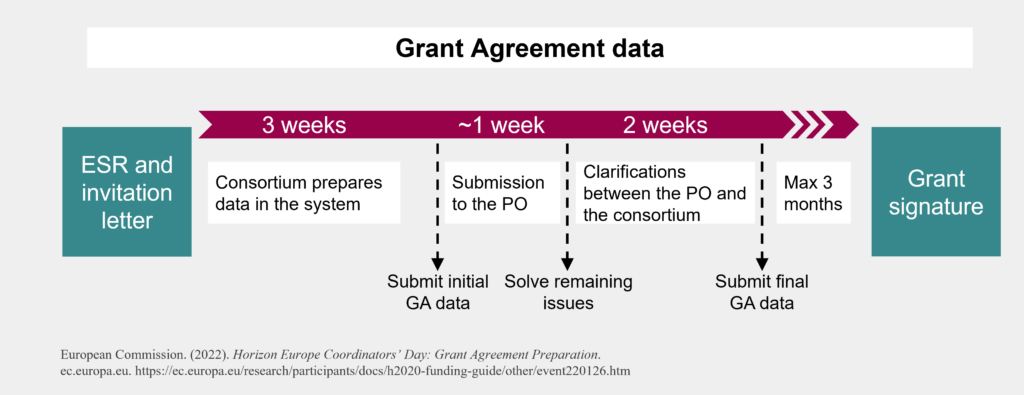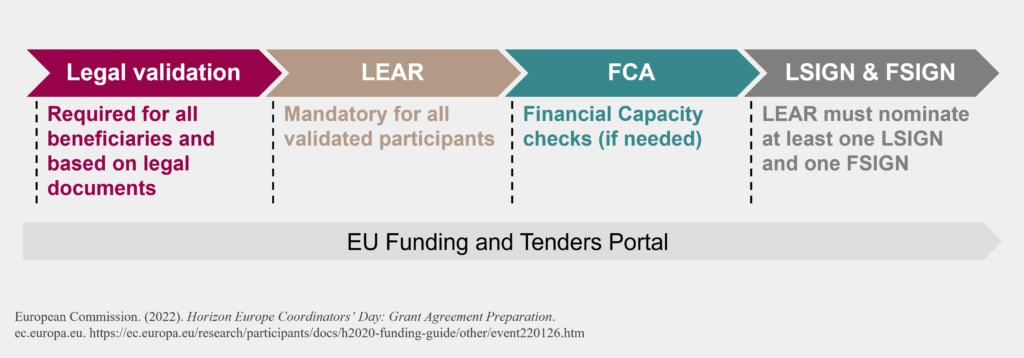Invited to prepare the Horizon EU Grant Agreement? Your journey is beginning!
31st March 2022 at 3:42 pm
Let’s start by picturing the best-case scenario – you received the Evaluation Summary Report (ESR) for your Horizon Europe proposal and are invited to start the Grant Agreement Preparation (GAP) with the European Commission (EC). Congratulations! While this is a moment of great excitement and one can feel the taste of “mission accomplished”, there is still a long way to go before the project is secured. The Grant Agreement Preparation can, at times, be quite a demanding and stressful process; so it is best to start as soon as possible rather than leaving it to the last-minute rush.
Each and every project has its own particularities, making it difficult to come up with a one-size-fits-all recipe to ensure the smoothest GAP possible. At accelopment, we have already been lucky to be involved in several GAPs for different types of Horizon EU projects and our administrative project managers have, thus, gathered extensive knowledge and insights into the GAP process for Horizon EU projects in the past months. With the hope of easing the process for other successful EU project coordinators and partners, summarised below are our team’s latest tips to navigate through a hopefully smooth GAP process.
Familiarise yourself with the EU Funding and Tenders Portal
The EU Funding and Tenders Portal is the main gateway for all exchanges with the EC and the Project Officer (PO). It is also the platform through which the proposal was first submitted, through which all key GAP-related documents will be available, and through which all project activities will be reported to the EC during the GAP and the project’s implementation. Hence, becoming familiar and comfortable with it is a must, for both the coordinator and other project partners.
Brace yourself for tight and strict deadlines
The completion of the GAP process is subject to strict timelines: a regulatory requirement of the EC that you need to follow. How does it all start?

First, the project coordinator and all project partners receive two important documents through the EU Funding and Tenders Portal: 1) the Evaluation Summary Report (ESR) and 2) the invitation letter that already specifies some deadlines applicable to the GAP. A few days later, the PO will usually contact the coordinator through the portal’s so-called Communication Centre with a list of requirements (in a third document) to be addressed within a specific period of usually 2-3 weeks.
With this information, the first actions by the coordinator and the consortium towards addressing the requirements and submitting the first Grant Agreement (GA) data can start. We highly recommend starting as soon as possible, both because of the tight deadlines first set in the invitation letter and in the PO’s requirements, but also because there might be additional rounds of GA data preparation and comments from the PO prior to submitting the final version (see Figure 1). Throughout the process and to avoid delays, we advise continuous, transparent, and timely communication by the coordinator as the single point of contact to the EC with the PO.
Admin essentials first: from validation to DoH signature
One of the first checks made by the EC concerns validation: If the PIC number (Participant Identification Code) of an organisation within the list of Beneficiaries is only declared and not validated, the person who initially registered the organisation in the portal will be requested to carry out the validation through the portal. Usually, this requires a series of documents to be uploaded to the portal within 5 days. These typically include:
- A completed legal entity identification form.
- Official VAT and registration extracts valid no longer than 6 months.
- Statutes or act of establishment.
The EC’s Central Validation Service is the entity in charge of the process and should be contacted in case of any issues or delays. Once validated, all organisations will need to nominate a Legal Entity Appointed Representative (LEAR), who will bear the ultimate responsibility for all the actions in the portal. This will also require providing a series of documentation, typically consisting of the LEAR appointment letter & LEAR role and duties, the declaration of consent to the portal terms and conditions, proof of identity, and documents proving the authority of the legal representative.

In some cases, the EC may also require a Financial Capacity Assessment (FCA) to guarantee that the institutions have the necessary capacities to implement the project. Regardless of whether an FCA is needed, the LEAR will have to appoint at least one Legal Signatory (LSIGN) in the portal who will be in charge of signing any legal documentation, and at least one Financial Signatory (FSIGN) who will have the right to sign the financial statements during the project’s implementation. The LSIGN will have to sign a Declaration of Honour (DoH) in the Funding & Tenders Portal before the grant agreement can be signed, to ensure that the beneficiary complies with the rules and is not in a situation that would exclude him from receiving EU funding (e.g., bankruptcy). The signature process is paperless and only takes a minute.
“No changes at all” is a myth: from the proposal Part B to the DoA
The letter of invitation to GAP will also request for the “Part B” document that was originally submitted as the main proposal narrative to be converted to the so-called Description of the Action (DoA). This will become an annex to the standard EU contract and, thus, a legal obligation. Converting Part B to the DoA consists of transferring all details of the work packages (WP), deliverables, milestones, risks, and Work Packages’ efforts to online forms on the portal (these will be part of the DoA Part A) while keeping the remainder of Part B in the PDF format (this will become the DoA Part B). We recommend first transferring the tables that will make up DoA Part A to a separate Word document and keeping these “offline” at first. The reason for this is that despite the fact that the GAP is prepared based on the proposal selected for funding due to its merit, the letter of invitation and the PO will in most cases request for minor edits to be made to fully meet all legal, financial, and ethics requirements. Moreover, the correction of clerical errors and minor inconsistencies at this stage are common and are very valuable. Completely flawless proposals are extremely rare and the ESR will most likely include comments on shortcomings that can be improved. Tackling the “not so good” comments, rectifying inconsistencies, and providing further clarifications and detailed information on the budget are common tasks during the GAP. Thus, working with two offline documents to address any required changes and implement minor edits, especially considering that these will usually require input from multiple partners, is an easier approach than having to edit the online forms on the portal for the DoA Part A.
Within the DoA Part B, we experienced that a detailed breakdown cost analysis is usually requested, especially for equipment, travel, and other goods and services, as well as the exact scope of each subcontracting item. Regardless of the changes required, it is crucial to keep track of all changes made to both Part A and Part B of the DoA (another reason why working offline in a document where changes can be easily tracked is also recommended for Part A, before copy-pasting the information into the online forms). It is extremely important to provide the DoA documents (both Part A and Part B) with the respective tracked changes, as the PO will review all changes made and might have additional requests to be addressed prior to the final version of the DoA being ready for final submission. Once the PO approves all changes, the Part A information is added to the forms on the portal and the final Part B can be uploaded as a PDF.
Last but not least: key legal and financial details to consider
The partners and PO will need to agree on a project start date as soon as possible. There is the possibility of setting a date retroactively, but in any case, a sound justification on scientific bases needs to be provided should the starting date differ from the default suggested by the EC. And no, summer or Christmas holidays are not a good justification.
For financial forecasting, it is always helpful to be aware of how much the prefinancing payment of the project will be and whether a Certificate on the Financial Statement (CFS) will need to be prepared. This information can be easily found in the “Financial Information” grant data in the portal. Depending on the number of Reporting Periods (RPs) scheduled for the project, the following prefinancing rates apply:
- 2 RPs – the prefinancing corresponds to 80% of the total EC funds
- 3 RPs – the prefinancing corresponds to 53.33% of the total EC funds
- 4 RPs – the prefinancing corresponds to 40% of the total EC funds.
The Mutual Insurance Mechanism (previously called Guarantee Fund) is 5% and will be retained by the EC. Regarding the CFS, in principle no partner is exempt, but only those requesting an EC contribution higher than EUR 430’000, have the certainty that they will have to prepare a CFS.
While preparing the GAP with the EC, it is also the best and right moment to already start drafting the Consortium Agreement between the Beneficiaries. The Associated Partners, who do not receive any EC contributions, do neither sign the DoH nor the GA, but the Consortium Agreement (CA) is the “piece of the puzzle” that unifies all partners and defines important and additional terms and conditions during project implementation. As there are typically varied and at times contrasting opinions between partners regarding the terms defined in the CA, we recommend initiating the process early and being prepared for multiple rounds of review. Note that the CA must not contain any provision contrary to the Grant Agreement.
Support for your grant preparation
While there are many aspects to consider and deadlines to keep track of during the GAP, it is a necessary step to set new projects off to a good start. Our team at accelopment has so far successfully guided dozens of project partners through the Grant Preparation process, including newly approved Horizon Europe consortia. To benefit from our team’s experience, contact us and we will be delighted to share our advice and support you towards a successful and smooth GAP.

Andreia Cruz
Research & Innovation Project Manager

